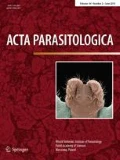Abstract
Microscopic examination results in patients with filariasis are often not identified by the presence of microfilaria, so it needs to be checked by Polymerase Chain Reaction (PCR). One PCR method uses High-Resolution Melting (HRM). The purpose of this study was to compare qPCR-HRM with microscopic examination methods to determine the types of microfilaria found in patients with filariasis. 19 samples were examined using a microscopic method and qPCR-HRM. The results of microscopic examination found no type of microfilaria and in qPCR-HRM identified B.malayi and W.bancrofti with peak temperature melting 78.1–78.7 ℃ and 80.2–80.8 ℃. The results of the study based on the comparison of two methods show that the types of microfilaria W.bancrofti and B.malayi can be found using qPCR-HRM.





References
Pusdatin Kemnkes RI (2016) Situasi Filariasis di Indonesia. Infodatin ISSN 2442–7659
Thanchomnang T, Intapan PM, Tantrawatpan C, Lulitanond V, Chungpivat S, Taweethavonsawat P et al (2013) Rapid detection and identification of Wuchereria bancrofti, Brugia malayi, B pahangi, and Dirofilaria immitis in mosquito vectors and blood samples by high resolution melting real-time PCR. Korean J Parasitol 51(6):645. https://doi.org/10.3347/kjp.2013.51.6.645
Lizotte MR, Supali T, Partono F, Williams SA (1994) A polymerase chain reaction assay for the detection of Brugia malayi in blood. Am J Trop Med Hyg 51(3):314–321. https://doi.org/10.4269/ajtmh.1994.51.314
Fischer P, Wibowo H, Pischke S, Ruckert P, Liebau E, Ismid IS et al (2002) PCR-based detection and identification of the filarial parasite Brugia timori from Alor Island Indonesia. Ann Trop Med Parasitol 96(8):809–821. https://doi.org/10.1179/000349802125002239
Bockarie MJ, Deb RM (2010) Elimination of lymphatic filariasis: do we have the drugs to complete the job? Curr Opin Infect Dis 23(6):617–620. https://doi.org/10.1097/QCO.0b013e32833fdee5
Goodman DS, Orelus J-N, Roberts JM, Lammie PJ, Streit TG (2003) PCR and mosquito dissection as tools to monitor filarial infection levels following mass treatment. Filaria J 2(1):11. https://doi.org/10.1186/14752883211
Rao RU, Weil GJ, Fischer K, Supali T, Fischer P (2006) Detection of Brugia parasite DNA in human blood by real-time PCR. J Clin Microbiol 44(11):3887–3893. https://doi.org/10.1128/JCM.00969-06
Hoti SL, Patra KP, Vasuki V, Lizotte MW, Hariths VR, Ravi VR et al (2002) Evaluation of Ssp I PCR assay in the detection of Wuchereria bancrofti infection in field collected Culex quinquefasciatus and its application in the transmission studies of lymphatic filariasis. J Appl Entomol 126:417–421
Hoti SL, Vasuki V, Lizotte MW, Patra KP, Ravi G, Vanamail P et al (2001) Detection of Brugia malayi in laboratory and wild-caught Mansonioides mosquitoes (Diptera: Culicidae) using Hha I PCR assay. Bull Entomol Res 91(2):87–92. https://doi.org/10.1079/BER200078
Vasuki V, Patra KP, Hoti SL (2001) A rapid and simplified method of DNA extraction for the detection of Brugia malayi infection in mosquitoes by PCR assay. Acta Trop 79(3):245–248. https://doi.org/10.1016/S0001-706X(01)00136-X
McCarthy J (2000) Diagnosis of lymphatic filarial infection. Lymphat filariasis 1:127–150
Santoso S, Suryaningtyas NH (2015) Spesies mikrofilaria pada penderita kronis filariasis secara mikroskopis dan Polymerase Chain Reaction (PCR) di Kabupaten Tanjung Jabung Timur. Media Penelit dan Pengemb Kesehat 25(4):249–256
Sopi IIPB (2014) Situasi Pasca Pengobatan Massal Filariasis Di Desa Buru Kaghu, Kecamatan Wewewa Selatan Sumba Barat Daya. J Ekol Kesehat 13(2):116–129
Wongkamchai S, Mayoon B, Wanachiwanawin D, Foongladda S, Boitano JJ, Nochote H et al (2014) Real-time PCR with high-resolution melting analysis for diagnosis of Lymphatic filariasis. JITMM Proc 3:23–30
Rao RU, Atkinson LJ, Ramzy RMR, Helmy H, Farid HA, Bockarie MJ et al (2006) A real-time PCR-based assay for detection of Wuchereria bancrofti DNA in blood and mosquitoes. Am J Trop Med Hyg 74(5):826–832
Rahmah N, Nurulhasanah O, Norhayati S, Zulkarnain I, Norizan M (2010) Comparison of conventional versus real-time PCR detection of Brugia malayi DNA from dried blood spots from school children in a low endemic area. Trop Biomed 27(1):54–59
Kanchanaraksa S (2008) Evaluation of diagnostic and screening tests: validity and reliability. Balt John Hopkins Univ
Akobeng AK (2007) Understanding diagnostic tests 1: sensitivity, specificity and predictive values. Acta Paediatr 96(3):338–341. https://doi.org/10.1111/j.1651-2227.2006.00180.x
Acknowledgements
We would like to thank OIE Collaborating Center on Foodborne Parasites in Asian-Pacific Region for providing knowledge instruction in detail.
Author information
Authors and Affiliations
Corresponding author
Ethics declarations
Conflict of interest
The authors declare that they have no confict of interest.
Ethical Approval
The research proposal was approved by the Health Ethics Commission of the Faculty of Medicine, Padjadjaran University and informed consent was obtained from research respondents. Aspects of research use the general principles of research ethics in humans, namely: respect for human dignity, beneficence, and justice. Number of the ethical protocol: No. 0318020341.
Additional information
Publisher's Note
Springer Nature remains neutral with regard to jurisdictional claims in published maps and institutional affiliations.
Rights and permissions
About this article
Cite this article
Ihsan, B.M., Berbudi, A., Agoes, R. et al. Microfilaria Positification Test Using Real-Time PCR Technique with HRM (High-Resolution Melting). Acta Parasit. 67, 496–503 (2022). https://doi.org/10.1007/s11686-021-00412-5
Received:
Accepted:
Published:
Issue Date:
DOI: https://doi.org/10.1007/s11686-021-00412-5

